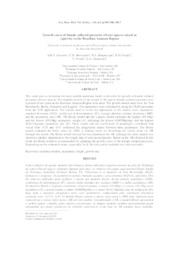Growth curve of female collared peccaries (Pecari tajacu) raised in captivity in the Brazilian Amazon Region.
Growth curve of female collared peccaries (Pecari tajacu) raised in captivity in the Brazilian Amazon Region.
Author(s): GARNERO, A. D. V.; MARCONDES, C. R.; ALBUQUERQUE, N. I. de; ARAÚJO, R. O.; PENDU, Y.; GUIMARÃES, D. A.
Summary: This work aims to determine the most suitable nonlinear model to describe the growth of female collared peccaries (Pecari tajacu). The monthly records of the weight of 10 captive female collared peccaries over a period of two years in the Brazilian Amazon Region were used. The growth models used were the Von Bertalanffy, Brody, Gompertz and Logistic. The parameters were estimated by using the NLIN procedure from the SAS application. The criteria used to verify the adjustment of the models were: asymptotic standard deviation (ASD); coefficient of determination (R²); average absolute residual deviation (ARD) and the asymptotic rate (AR). The Brody model and the Logistic model estimated the highest (19.44kg) and the lowest (19.18kg) asymptotic weight (A), indicating the lowest (0.0070kg/day) and the highest (0.0121kg/day) maturation rate (K). These results and the coefficients of phenotypic correlation that varied from -0.75 and -0.47 confirmed the antagonistic nature between these parameters. The Brody model estimated the lower value for ARD, a limiting factor for describing the lowest value for AR through this model. The Brody model showed the best adjustment for AR, although the other models also showed a suitable adjustment to the weight data of said species/gender. Based on the AR obtained in this work, the Brody model is recommended for adjusting the growth curve of the female collared peccaries. Depending on the estimated values, especially for K, this trait can be included in a selection index.
Publication year: 2013
Types of publication: Journal article
Keywords: Asymptotic weight, Cateto, Growth rate, nonlinear models
Observation
Some of Embrapa's publications are published as ePub files. To read them, use or download one of the following free software options to your computer or mobile device. Android: Google Play Books; IOS: iBooks; Windows and Linux: Calibre.
Access other publications
Access the Agricultural Research Database (BDPA) to consult Embrapa's full library collection and records.
Visit Embrapa Bookstore to purchase books and other publications sold by Embrapa.

